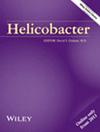Lipidome Characterization Reveals Alterations of Fatty Acid Metabolism in Helicobacter pylori Infection
Abstract
Background
Helicobacter pylori (H. pylori) is a pathobiont that infects around two-thirds of the global population and has demonstrated a rise in antibiotic resistance, warranting a search for alternative treatments. As fatty acid biosynthesis is central to membrane structure and function, and H. pylori is correlated with the erosion of the mucosal barrier, lipidome analysis can elucidate the role of fatty acid metabolism in H. pylori infection and yield potential targets for intervention.
Materials and Methods
Fecal samples from 68 H. pylori patients and 35 healthy control subjects were analyzed for fatty acid composition using gas chromatography–mass spectrometry.
Results
We observed an increase in margaric acid/17:0, eicosapentaenoic acid (EPA)/20:5n3, erucic acid/22:1n9, and docosapentaenoic acid (DPA)/22:5n3 as well as eicosatetraenoic acid/20:4n3 and docosahexaenoic acid (DHA)/22:6n3 in H. pylori patients relative to the healthy control subjects. In contrast, the PUFAs gamma-linolenic acid/18:3n6 and osbond acid/22:5n6 were decreased in the H. pylori patients relative to healthy controls. Most of the fatty acids that differ in quantity between H. pylori-positive samples and controls are metabolites of omega-3 and omega-6 fatty acid metabolism. Smoking, alcohol use, and non-ulcer dyspepsia further influenced fatty acid metabolism during H. pylori infection.
Conclusions
Here, we propose a model for the pathophysiology of H. pylori infection based on the gut lipid signatures of H. pylori patients and healthy control subjects. Our results may provide insight on how H. pylori infection leads to changes in fatty acid metabolism, how the host responds, and which metabolites may serve as potential candidates for future interventions.

 求助内容:
求助内容: 应助结果提醒方式:
应助结果提醒方式:


